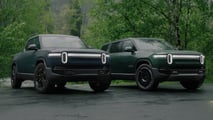
Not to worry, Rivian fans. Your gear shifters are safe.
Rivian founder and CEO RJ Scaringe said on MotorTrend’s "The InEVitable" podcast that the startup won’t go the way of Tesla, which eliminated gear-shifter stalks in some of its cars.
“You can imagine, we’ve had all those debates,” Scaringe said in response to a question about removing physical controls and stuffing functions into the touchscreen. “On the PRNDL side, yes you could save some costs, but we don’t see it as a customer benefit.”
Get Fully Charged
Cars are getting more digital
Many car companies are looking to remove physical controls and rely more on touchscreens. That saves them money and cleans up the look of a car's interior. But it has to stop somewhere, Rivian CEO RJ Scaringe says.
Rivian's next-generation R2 and R3 SUVs rethink some parts of the company's current R1S and R1T vehicles. But the shifter is sticking around.
Tesla, meanwhile, doesn’t provide a typical stalk or lever for changing between park, drive and reverse in the Model 3, Model X, Model S and Cybertruck. Those also eschew a turn-signal stalk in favor of steering wheel-mounted buttons. (The one exception here is the Model Y, but expect that to change once the long-rumored “Juniper” refresh hits the scene.)
Gallery: 2025 Rivian R1T and R1S







In those new Teslas, you shift gears by swiping up and down on the leftmost section of the touchscreen. You can also allow the car to choose the appropriate gear for you via the Auto Shift out of Park feature, which is in beta. In the case that the touchscreen stops functioning, stalk-less models also have redundant PRND buttons either above the rear-view mirror, or down by the cupholders.
In general, automakers can save on costs by eliminating physical parts and porting more functions over to a digital interface. Tesla pioneered that movement and has taken it to the extreme. But not all Tesla owners are fans of the stalk-less user experience. Scaringe didn't mention Tesla by name, but he seems to agree.
Rivian’s CEO said the company didn’t put physical heating and air conditioning controls in its vehicles—another controversial decision—because it saves the company money, makes the interior look cleaner and offers “real advantages that come over time.” For example, Rivian recently added vent-position presets to its cars, so drivers don’t need to manually redirect them via the touchscreen every time they want to change the flow of air.
As far as removing physical controls goes, he said he thinks Rivian has reached the right balance.
Contact the author: tim.levin@insideevs.com







